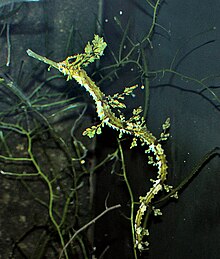The longsnout pipefish is a pipefish of the family Syngnathidae. It has only been recorded from midwater and bottom trawls at depths of 37–212 metres (121–696 ft). The habitat and biology of this species are almost unknown but juveniles have been recorded in the stomachs of blue penguins and Snares penguins.
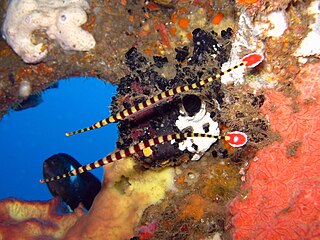
The banded pipefish or ringed pipefish is a species of fish in the Syngnathidae family.
The spinach pipefish is a species of fish in the family Syngnathidae. It is endemic to Papua New Guinea. The species was last seen in 1985.
Duncker's pipehorse, also known as the nose-ridge pipefish, red-and-gold pipehorse, red-hair pipefish or spiny sea dragon, is a species of fish in the family Syngnathidae. It is endemic to eastern Australia and Lord Howe Island. It is a pelagic species which is found in the waters of the continental shelf and the continental slope. Fishermen within its range report that it is caught where there are hard substrates such as hard sand, shale, sandstone or gravel and they are often caught alongside gorgonians, black corals, algae or sponges. It is an ovoviviparous species in which the male bears the fertilised eggs in a brood pouch located under his tail. It is a carnivorous species which feeds on small planktonic crustacean.

The alligator pipefish or double-ended pipefish is a species of fish in the family Syngnathidae and is the only species in the monotypic genus Syngnathoides. It is found in shallow water in the tropical and subtropical Indo-Pacific, its range extending from East Africa to northern Australia. This fish lives in habitats of seagrass and seaweed, and hides by positioning itself vertically with its head down amidst the similar-coloured fronds of vegetation. The elongated, well-camouflaged body can reach 29 cm (11 in) in length. It feeds by sucking up its prey.
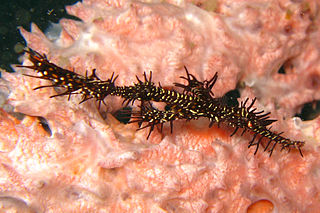
The ornate ghost pipefish or harlequin ghost pipefish, Solenostomus paradoxus, is a false pipefish of the family Solenostomidae. The species' name comes from the Greek paradoxos, referring to this fish's unusual external features. Ornate ghost pipefish are found in the Western Pacific and the Indian Ocean along reef edges prone to strong currents from the Red Sea to Tonga. They reach a maximum length of 12 cm. They vary in color from red or yellow to black and are almost transparent. Although relatively common, ornate ghost pipefish are very well-camouflaged and difficult to find. It occurs either as solitary individuals or in pairs, among the branches of gorgonians, in floating weeds, or crinoids where the feed on mysids and small benthic shrimp.

Corythoichthys intestinalis, known commonly as the scribbled pipefish, is a species of marine fish in the family Syngnathidae. Other common names used include banded pipefish, Australian banded pipefish, Australian messmate pipefish and messmate pipefish.
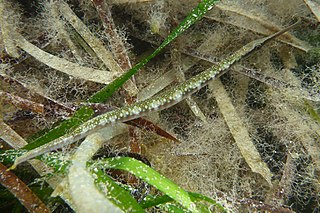
Leptoichthys fistularius, the brush-tailed pipefish, is a species of pipefish of the family Syngnathidae, found in shallow to intermediate depths off the coast of southern Australia, usually in seagrass beds. This species is the largest known species of pipefish, growing to a maximum of 63 cm (25 in) in length. Like other pipefishes, the male carries the fertilized eggs in a pouch under his tail until they hatch. The genus name comes from the Greek leptos meaning "thin" and ichthys meaning "fish", the specific name refers to the resemblance of the head of this species to that of the fluteheads or cornetfishes of the family Fistulariidae.
The upside-down pipefish is a species of pipefish endemic to the coast of southern Australia, from New South Wales to Geographe Bay in Western Australia, where it is found in rocky reefs at depths of from 2 to 15 metres. It grows to a length of 9.2 centimetres (3.6 in) SL. This species is the only known member of its genus. Like other pipefish it is ovoviviparous but it may breed seasonally, as gravid males have been collected between September and November.
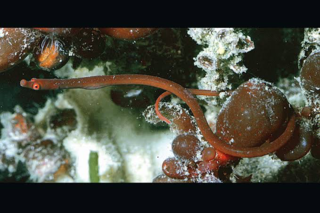
Notiocampus ruber, known commonly as the red pipefish, is a species of pipefish endemic to the Indian Ocean waters along the southern coast of Australia and Tasmania. It occurs at depths from 5 to 20 m over the continental shelf. This species grows to a length of 16.4 cm (6.5 in). This species is the only known member of its genus.

The ring-backed pipefish is a species of pipefish found in the waters of the Indian Ocean off the southern coast of Australia. It occurs on reefs in beds of red and brown algae down to depths of 15 metres (49 ft). This species grows to a length of 22 centimetres (8.7 in) SL. This species is the only known member of its genus.
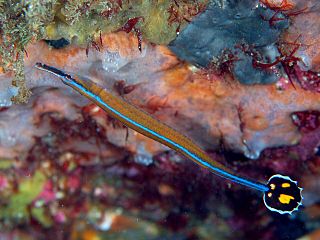
Doryrhamphus japonicus, or the Honshu pipefish, is a species of flagtail pipefish from the genus Doryrhamphus that occurs in the Western Pacific Ocean, from Milne Bay, Papua New Guinea, to Sulawesi, Indonesia, the Philippines, and north as far as Honshu, Japan and Korea. It is a marine demersal pipefish that inhabits coastal lagoons, rocky and coral reefs, and tidal pools down to as deep as 30 metres (98 ft) but it is unusual below 10 metres (33 ft). This species is frequently found in association with sea urchins of the genus Diadema and with sponges. It is an active cleaner, feeding on parasites found on other fishes. It frequently shares crevices with shrimps, large mud crabs and occasionally moray eels.
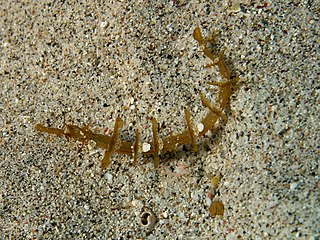
Halicampus macrorhynchus or also commonly known as the ornate pipefish , whiskered pipefish or winged pipefish is a species of fish in the family Syngnathidae.

Stigmatopora argus, the spotted pipefish, is a species of ray-finned fish from the family of pipefish and seahorses (Syngnathidae). The scientific name of the species is the first validly published in 1840 by Richardson.
Bhanotia fasciolata is a marine fish of the family Syngnathidae. It is found in coral reefs, tidepools, and muddy/silty substrates in the Eastern Indian Ocean and Western Pacific. It inhabits at a depth range of 3–25 metres (9.8–82.0 ft), where it can grow up to 9 centimetres (3.5 in). It is ovoviviparous, with the male carrying the eggs in a brood pouch until they are ready to hatch.
Choeroichthys suillus is a species of marine fish of the family Syngnathidae. It is endemic to Australia, occurring from Perth, along northern Australia, to southern Queensland. It lives in coral reefs to a depth of 14 metres (46 ft), where it can grow to lengths of 6 centimetres (2.4 in). This species is ovoviviparous, with males carrying eggs and giving birth to live young. Within the reef it is found among coral rubble.

Corythoichthys benedetto, commonly known as Benedetto's pipefish, is a species of marine fish of the family Syngnathidae. It inhabits the Indo-West Pacific, near Thailand, Myanmar, Indonesia, Papua New Guinea, and Australia. It is found on algae-covered rocky surfaces and gorgonian sea fans at depths of 5 to 20 metres, where it can grow to lengths of around 7 centimetres (2.8 in). It is usually found alone, although it can be found in groups of up to four individuals. This species is ovoviviparous, with males brooding when they are at lengths of 5 to 5.5 centimetres. The specific name and common name honour the late Italian prime minister Benedetto Craxi (1934-2000).
Festucalex kulbickii, commonly known as Kulbicki's pipefish, or New Caledonian pipefish, is a species of marine fish of the family Syngnathidae. It is found from West Papua, Indonesia and Papua New Guinea to New Caledonia. It lives in coral reefs to depths of 56 metres (184 ft), where it can grow to lengths of 6.8 centimetres (2.7 in). It is expected to feed on small crustaceans, similar to other pipefish. This species is ovoviviparous, with males brooding eggs and giving birth to live young. The specific name honours Dr. Michel Kulbicki of L’Institut de recherche pour le développement (IRD) in Nouméa, New Caledonia.
Wass's pipefish is a species of marine fish of the family Syngnathidae. It is known from only six species, which were found in the coastal waters of Papua New Guinea, New Caledonia, Fiji, and Samoa. It inhabits soft coral habitats and coral rubble to depths of 50 metres (160 ft), where it can grow to lengths of 7.4 centimetres (2.9 in). Little is known of the species’ feeding habits, but it is expected to eat small crustaceans, similar to other pipefish. This species is ovoviviparous, with males carrying eggs and giving birth to live young. The specific name honours the U.S. Fish & Wildlife Service biologist Richard C. Wass.
The short-keel pipefish is a species of fish of the family Syngnathidae. It is known from Darwin to the Torres Strait and southern Papua New Guinea. It lives in coastal fresh and brackish habitats, such as mudflats, mangroves, gravel, sandy and rocky habitats, and coral and shell rubble. It can grow to lengths of 12 centimetres (4.7 in). It is expected to feed on small crustaceans such as copepods, shrimps and mysids, similar to other pipefish. This species is ovoviviparous, with males carrying eggs in a brood pouch before giving birth to live young. Males may brood at 7.8 centimetres (3.1 in).
